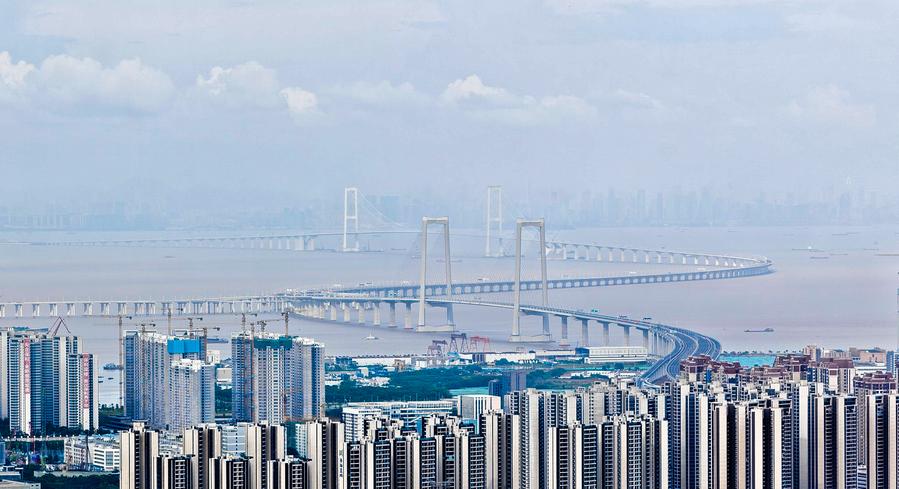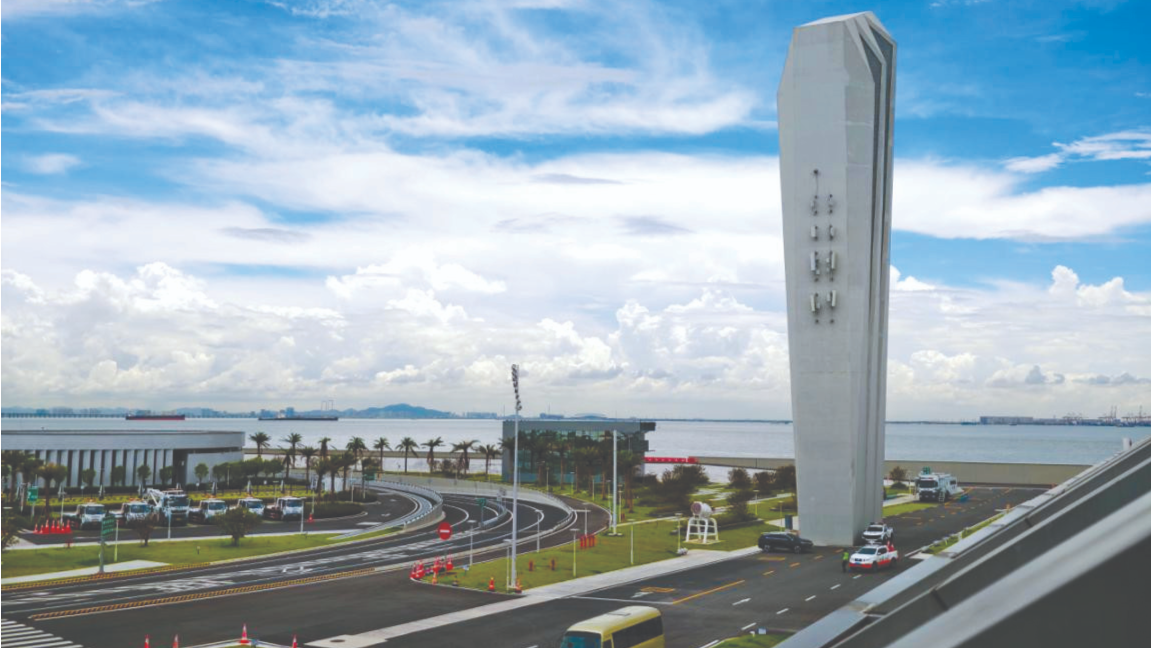
In the year since its opening, the Shenzhen–Zhongshan Link has fueled regional connectivity by enhancing people exchanges and industrial coordination, with the effect extending to Hong Kong.
To make best use of the link’s potential, experts recommend to easing congestion, accelerating cross-boundary rail transit development, and expanding the of “Northbound Travel for Hong Kong Vehicles” program to Shenzhen.
Opened on June 30 last year, the 24-kilomere-long combined bridge and tunnel, which is the third transportation corridor spanning the Pearl River Estuary after Humen Bridge and the Hong Kong-Zhuhai-Macao Bridge (HZMB), cut travel time between Shenzhen and Zhongshan from two hours to about thirty minutes.
READ MORE: Shenzhong Link moves a step closer to its official opening
Guo Wanda, executive vice-president of the China Development Institute, said that by expediting the flow of essential production elements, the link has deepened cluster integration on both sides of the Pearl River Delta and may reshape the industrial landscape of the Guangdong-Hong Kong-Macao Greater Bay Area (GBA).
Currently, the link hosts an average of 86,000 vehicle trips per day, with a peak of 181,600 on the first day of this year’s Labor Day holiday. Annual traffic is projected to reach 31 million trips.

With five daily routes connecting Zhongshan with Shenzhen and Guangzhou, the link’s cross-city bus service recently recorded over 3 million passenger trips.
With the corridor's opening, tourism in Zhongshan and nearby Jiangmen city has reached new heights. As part of the plan to build the link into a comprehensive landmark, its western artificial island is due to open for tourism by the end of this year.
Building upon this new infrastructure link, Shenzhen and Zhongshan have further strengthened institutional connections, allowing 735 kinds of government services to be processed in both cities.
With lowered logistics costs and enhanced efficiency due to the link, more Shenzhen companies are shifting production to Zhongshan, including Arashi Vision Inc that develops panoramic cameras and sports cameras, and LED application producer Unilumin Group. Some have also relocated part of their research work to this manufacturing hub.
Guo noted that in addition to the information technology industry on the east bank, the manufacturing sector on the west bank is also actively innovating, embracing the latest wave of artificial intelligence (AI). He said he believes that the integration of elements on both sides may redefine the industrial division in the future. The lower cost of living and abundant land resources in the west can also help it attract more talent and support greater research functions.
The link’s traffic flow far exceeds the initial operating figures of similar cross-harbor corridors. Guo called for greater efforts to ease congestion and improve infrastructure, suggesting the adoption of technological and economic approaches to manage traffic in peak times and enhancing coordinated management of the link between Shenzhen and Zhongshan.
To relieve the pressure on the Shenzhen-Zhongshan Link and improving the regional transportation network, he said he envisioned the accelerated development of railway transportation across the Pearl River Estuary. For cargo business, he looks forward to more cooperation between the east and west banks in the area of low-altitude economy.
Such railway projects include a Shenzhen-Zhuhai sea-crossing bridge, a dual-use passage for both road and rail, which is in the preparation stage, as well as the Shenzhen-Jiangmen high-speed railway, scheduled to open in 2028.
Guo emphasized that the link also serves as a gateway for passenger and goods flow between Hong Kong and Zhongshan, urging Hong Kong to deepen cooperation with the western Pearl River Delta.
Hong Kong lawmaker Gary Zhang Xinyu noted that the Shenzhen-Zhongshan Link has further facilitated intercity trips, with an increasing number of Hong Kong vehicles reaching the Chinese mainland through the HZMB by using the link to reach Shenzhen and nearby locations.
Logistics transportation between Hong Kong and Zhongshan has also established a new methodology. After passing through the Shenzhen-Zhongshan Link, goods are sorted at the Hung Shui Kiu logistics center near the Shenzhen Bay Bridge, and then dispatched to Kwai Tsing Container Terminals or Hong Kong International Airport (HKIA).
To allow Hong Kong people to further leverage the link, he suggested expanding the quota-free scheme that allows Hong Kong private cars with only local license to travel to Guangdong via the HZMB to Shenzhen Bay Port, which is close to the Shenzhen entry point of the link.
READ MORE: Shenzhen-Zhongshan Link sets new daily traffic record
He said he anticipated that the upcoming Hong Kong-Shenzhen Western Rail Link will also allow Hong Kong to take advantage of the Shenzhen-Zhongshan Link. Forecast to connect Shenzhen’s Qianhai area to Hong Kong’s Hung Shui Kiu in 15 minutes, the project is scheduled to be tendered in 2027 and starts operation in 2035.
In addition, Zhang mentioned the deepening understanding of Hong Kong enterprises of the industry potential on the west bank of the Pearl River Estuary, especially in smart manufacturing and prefabricated construction. These developments have also been eye-opening for Hong Kong lawmakers during their exchange trips.
He stated that the production and innovation capabilities in the western Pearl River region are a valuable complement to Hong Kong, particularly given the significant construction demand in the development of the Northern Metropolis. “To enhance complementary growth between the two regions, there is plenty of work can be done,” he said.
Contact the writer at bingcun@chinadailyhk.com


